Employee Resistance to Change and Voice: A Leadership Perspective
VerifiedAdded on 2023/04/08
|10
|2037
|473
Homework Assignment
AI Summary
This assignment solution delves into key aspects of change management, focusing on employee resistance, the importance of employee voice, and voluntary redundancy strategies. It addresses Kotter's reasons for resistance to change, highlighting the significance of education, communication, participation, and negotiation in successful change implementation, drawing examples from Continental Airlines. The analysis explores the impact of ignoring employee voice on organizational performance, emphasizing the benefits of individual and group voice in fostering creativity and commitment. Additionally, the solution discusses voluntary redundancy as a downsizing strategy, comparing it to involuntary redundancy and recommending its use for Business Information Solutions (BIS) while stressing the importance of communication and employee involvement. Desklib provides access to a wealth of similar solved assignments and AI-powered study tools to support students in their academic pursuits.
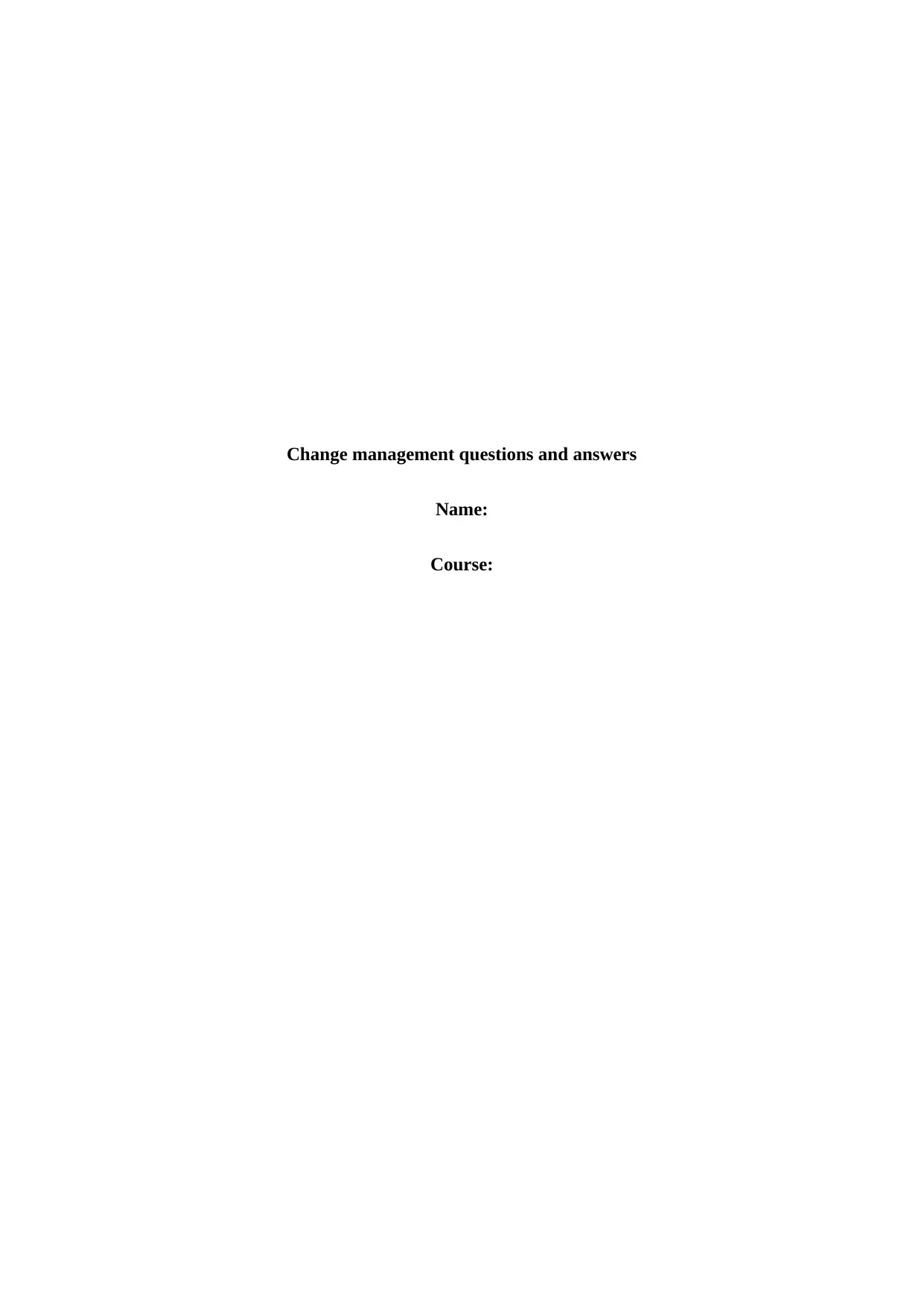
Change management questions and answers
Name:
Course:
Name:
Course:
Paraphrase This Document
Need a fresh take? Get an instant paraphrase of this document with our AI Paraphraser
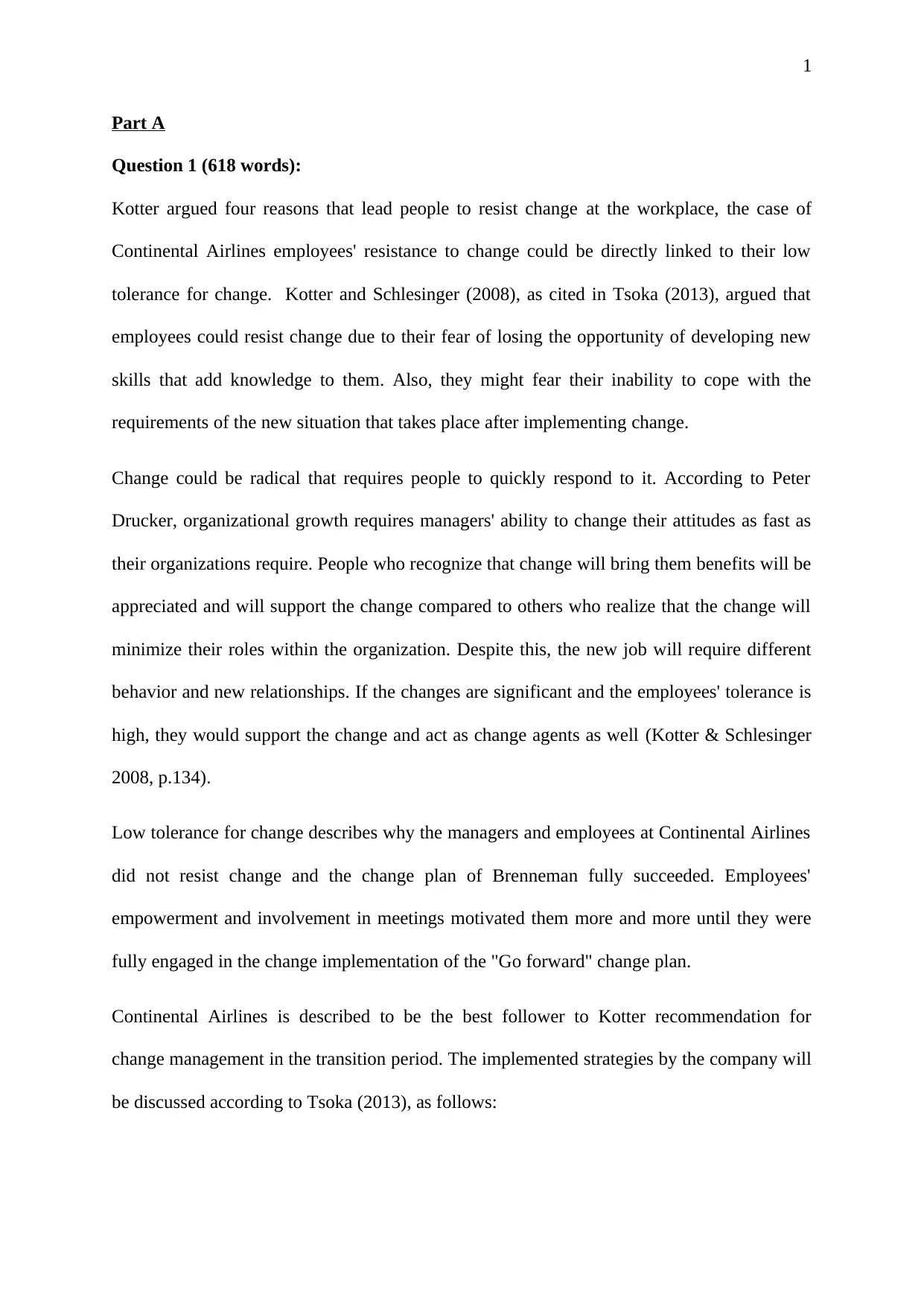
1
Part A
Question 1 (618 words):
Kotter argued four reasons that lead people to resist change at the workplace, the case of
Continental Airlines employees' resistance to change could be directly linked to their low
tolerance for change. Kotter and Schlesinger (2008), as cited in Tsoka (2013), argued that
employees could resist change due to their fear of losing the opportunity of developing new
skills that add knowledge to them. Also, they might fear their inability to cope with the
requirements of the new situation that takes place after implementing change.
Change could be radical that requires people to quickly respond to it. According to Peter
Drucker, organizational growth requires managers' ability to change their attitudes as fast as
their organizations require. People who recognize that change will bring them benefits will be
appreciated and will support the change compared to others who realize that the change will
minimize their roles within the organization. Despite this, the new job will require different
behavior and new relationships. If the changes are significant and the employees' tolerance is
high, they would support the change and act as change agents as well (Kotter & Schlesinger
2008, p.134).
Low tolerance for change describes why the managers and employees at Continental Airlines
did not resist change and the change plan of Brenneman fully succeeded. Employees'
empowerment and involvement in meetings motivated them more and more until they were
fully engaged in the change implementation of the "Go forward" change plan.
Continental Airlines is described to be the best follower to Kotter recommendation for
change management in the transition period. The implemented strategies by the company will
be discussed according to Tsoka (2013), as follows:
Part A
Question 1 (618 words):
Kotter argued four reasons that lead people to resist change at the workplace, the case of
Continental Airlines employees' resistance to change could be directly linked to their low
tolerance for change. Kotter and Schlesinger (2008), as cited in Tsoka (2013), argued that
employees could resist change due to their fear of losing the opportunity of developing new
skills that add knowledge to them. Also, they might fear their inability to cope with the
requirements of the new situation that takes place after implementing change.
Change could be radical that requires people to quickly respond to it. According to Peter
Drucker, organizational growth requires managers' ability to change their attitudes as fast as
their organizations require. People who recognize that change will bring them benefits will be
appreciated and will support the change compared to others who realize that the change will
minimize their roles within the organization. Despite this, the new job will require different
behavior and new relationships. If the changes are significant and the employees' tolerance is
high, they would support the change and act as change agents as well (Kotter & Schlesinger
2008, p.134).
Low tolerance for change describes why the managers and employees at Continental Airlines
did not resist change and the change plan of Brenneman fully succeeded. Employees'
empowerment and involvement in meetings motivated them more and more until they were
fully engaged in the change implementation of the "Go forward" change plan.
Continental Airlines is described to be the best follower to Kotter recommendation for
change management in the transition period. The implemented strategies by the company will
be discussed according to Tsoka (2013), as follows:
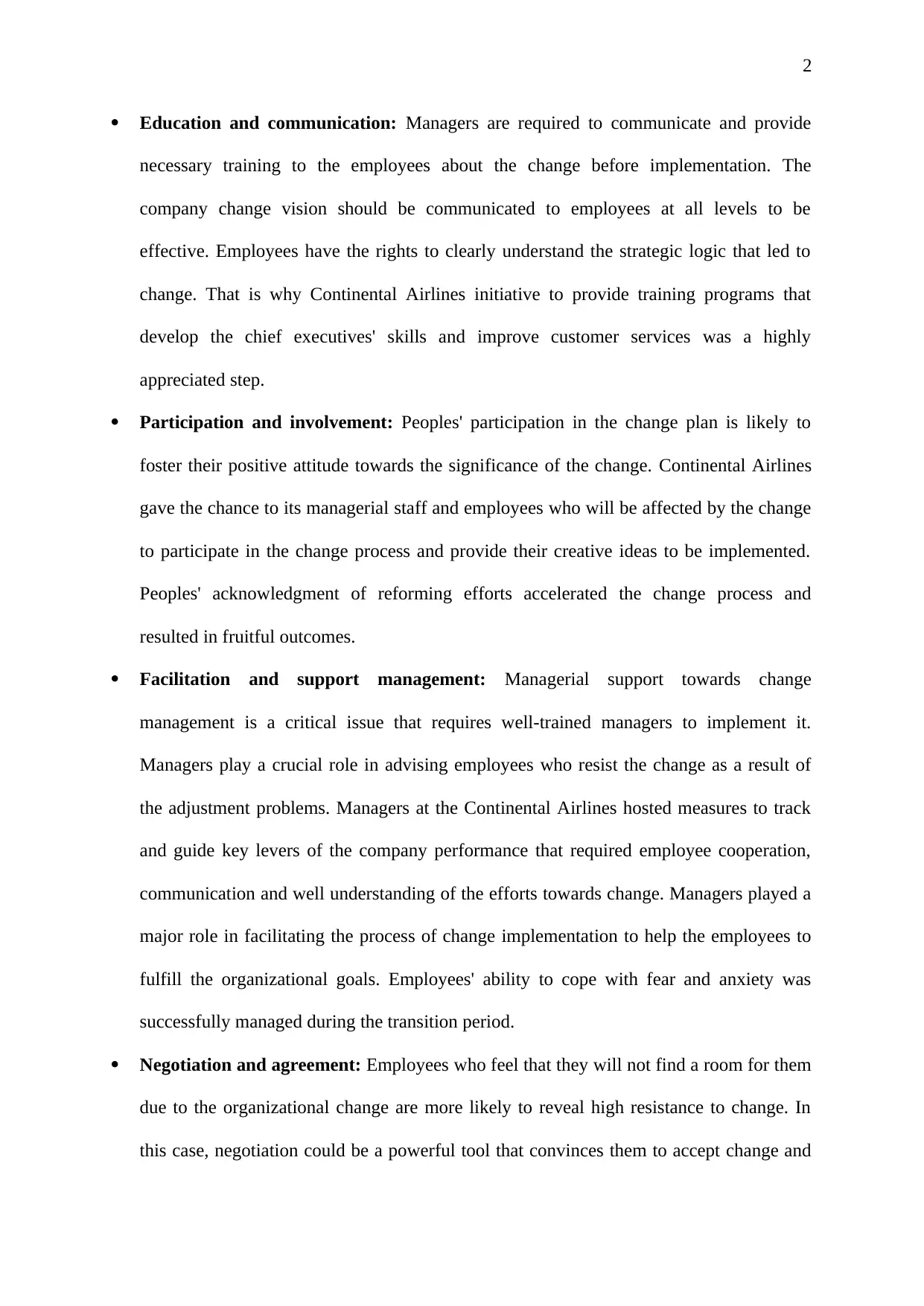
2
Education and communication: Managers are required to communicate and provide
necessary training to the employees about the change before implementation. The
company change vision should be communicated to employees at all levels to be
effective. Employees have the rights to clearly understand the strategic logic that led to
change. That is why Continental Airlines initiative to provide training programs that
develop the chief executives' skills and improve customer services was a highly
appreciated step.
Participation and involvement: Peoples' participation in the change plan is likely to
foster their positive attitude towards the significance of the change. Continental Airlines
gave the chance to its managerial staff and employees who will be affected by the change
to participate in the change process and provide their creative ideas to be implemented.
Peoples' acknowledgment of reforming efforts accelerated the change process and
resulted in fruitful outcomes.
Facilitation and support management: Managerial support towards change
management is a critical issue that requires well-trained managers to implement it.
Managers play a crucial role in advising employees who resist the change as a result of
the adjustment problems. Managers at the Continental Airlines hosted measures to track
and guide key levers of the company performance that required employee cooperation,
communication and well understanding of the efforts towards change. Managers played a
major role in facilitating the process of change implementation to help the employees to
fulfill the organizational goals. Employees' ability to cope with fear and anxiety was
successfully managed during the transition period.
Negotiation and agreement: Employees who feel that they will not find a room for them
due to the organizational change are more likely to reveal high resistance to change. In
this case, negotiation could be a powerful tool that convinces them to accept change and
Education and communication: Managers are required to communicate and provide
necessary training to the employees about the change before implementation. The
company change vision should be communicated to employees at all levels to be
effective. Employees have the rights to clearly understand the strategic logic that led to
change. That is why Continental Airlines initiative to provide training programs that
develop the chief executives' skills and improve customer services was a highly
appreciated step.
Participation and involvement: Peoples' participation in the change plan is likely to
foster their positive attitude towards the significance of the change. Continental Airlines
gave the chance to its managerial staff and employees who will be affected by the change
to participate in the change process and provide their creative ideas to be implemented.
Peoples' acknowledgment of reforming efforts accelerated the change process and
resulted in fruitful outcomes.
Facilitation and support management: Managerial support towards change
management is a critical issue that requires well-trained managers to implement it.
Managers play a crucial role in advising employees who resist the change as a result of
the adjustment problems. Managers at the Continental Airlines hosted measures to track
and guide key levers of the company performance that required employee cooperation,
communication and well understanding of the efforts towards change. Managers played a
major role in facilitating the process of change implementation to help the employees to
fulfill the organizational goals. Employees' ability to cope with fear and anxiety was
successfully managed during the transition period.
Negotiation and agreement: Employees who feel that they will not find a room for them
due to the organizational change are more likely to reveal high resistance to change. In
this case, negotiation could be a powerful tool that convinces them to accept change and
⊘ This is a preview!⊘
Do you want full access?
Subscribe today to unlock all pages.

Trusted by 1+ million students worldwide
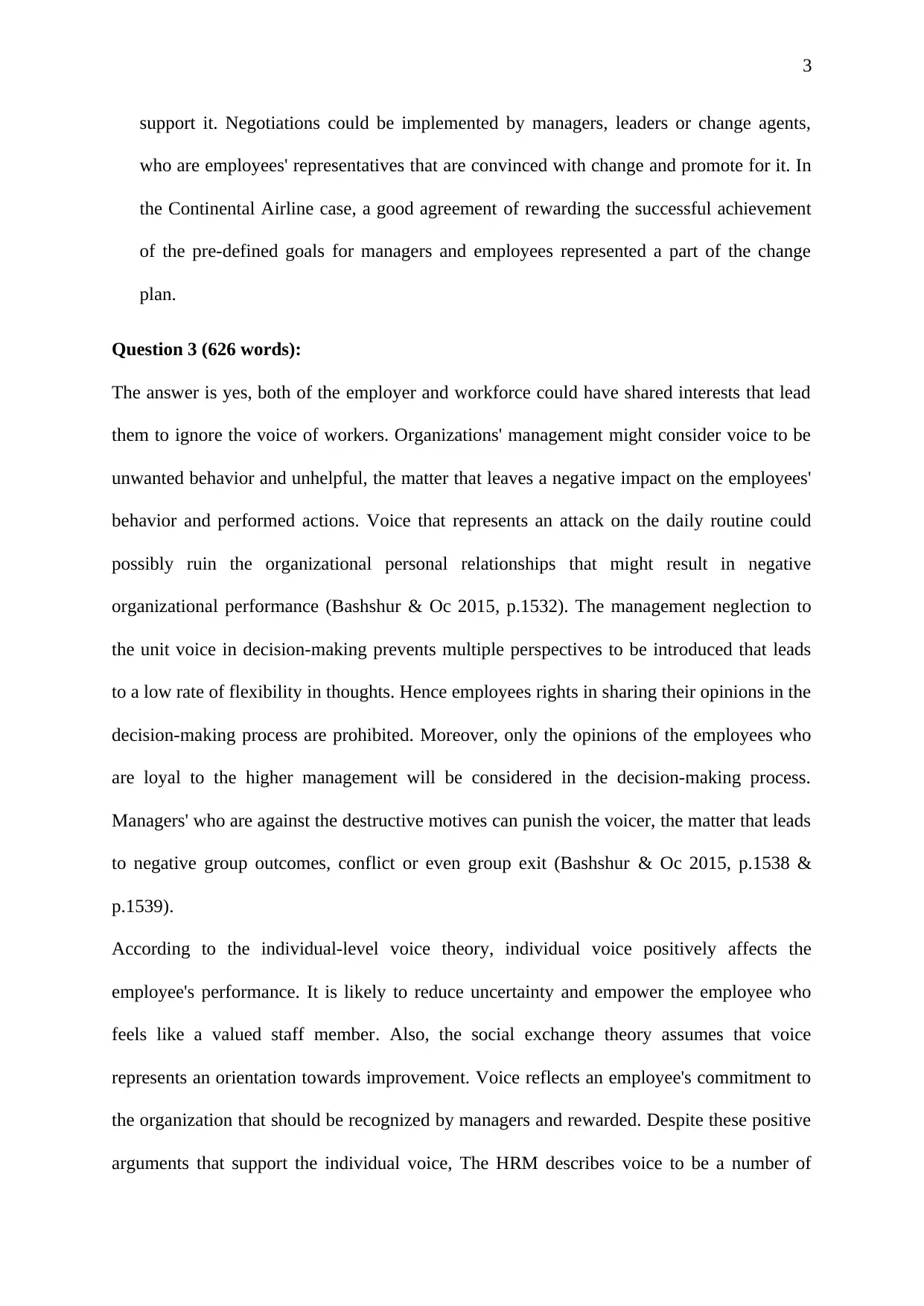
3
support it. Negotiations could be implemented by managers, leaders or change agents,
who are employees' representatives that are convinced with change and promote for it. In
the Continental Airline case, a good agreement of rewarding the successful achievement
of the pre-defined goals for managers and employees represented a part of the change
plan.
Question 3 (626 words):
The answer is yes, both of the employer and workforce could have shared interests that lead
them to ignore the voice of workers. Organizations' management might consider voice to be
unwanted behavior and unhelpful, the matter that leaves a negative impact on the employees'
behavior and performed actions. Voice that represents an attack on the daily routine could
possibly ruin the organizational personal relationships that might result in negative
organizational performance (Bashshur & Oc 2015, p.1532). The management neglection to
the unit voice in decision-making prevents multiple perspectives to be introduced that leads
to a low rate of flexibility in thoughts. Hence employees rights in sharing their opinions in the
decision-making process are prohibited. Moreover, only the opinions of the employees who
are loyal to the higher management will be considered in the decision-making process.
Managers' who are against the destructive motives can punish the voicer, the matter that leads
to negative group outcomes, conflict or even group exit (Bashshur & Oc 2015, p.1538 &
p.1539).
According to the individual-level voice theory, individual voice positively affects the
employee's performance. It is likely to reduce uncertainty and empower the employee who
feels like a valued staff member. Also, the social exchange theory assumes that voice
represents an orientation towards improvement. Voice reflects an employee's commitment to
the organization that should be recognized by managers and rewarded. Despite these positive
arguments that support the individual voice, The HRM describes voice to be a number of
support it. Negotiations could be implemented by managers, leaders or change agents,
who are employees' representatives that are convinced with change and promote for it. In
the Continental Airline case, a good agreement of rewarding the successful achievement
of the pre-defined goals for managers and employees represented a part of the change
plan.
Question 3 (626 words):
The answer is yes, both of the employer and workforce could have shared interests that lead
them to ignore the voice of workers. Organizations' management might consider voice to be
unwanted behavior and unhelpful, the matter that leaves a negative impact on the employees'
behavior and performed actions. Voice that represents an attack on the daily routine could
possibly ruin the organizational personal relationships that might result in negative
organizational performance (Bashshur & Oc 2015, p.1532). The management neglection to
the unit voice in decision-making prevents multiple perspectives to be introduced that leads
to a low rate of flexibility in thoughts. Hence employees rights in sharing their opinions in the
decision-making process are prohibited. Moreover, only the opinions of the employees who
are loyal to the higher management will be considered in the decision-making process.
Managers' who are against the destructive motives can punish the voicer, the matter that leads
to negative group outcomes, conflict or even group exit (Bashshur & Oc 2015, p.1538 &
p.1539).
According to the individual-level voice theory, individual voice positively affects the
employee's performance. It is likely to reduce uncertainty and empower the employee who
feels like a valued staff member. Also, the social exchange theory assumes that voice
represents an orientation towards improvement. Voice reflects an employee's commitment to
the organization that should be recognized by managers and rewarded. Despite these positive
arguments that support the individual voice, The HRM describes voice to be a number of
Paraphrase This Document
Need a fresh take? Get an instant paraphrase of this document with our AI Paraphraser
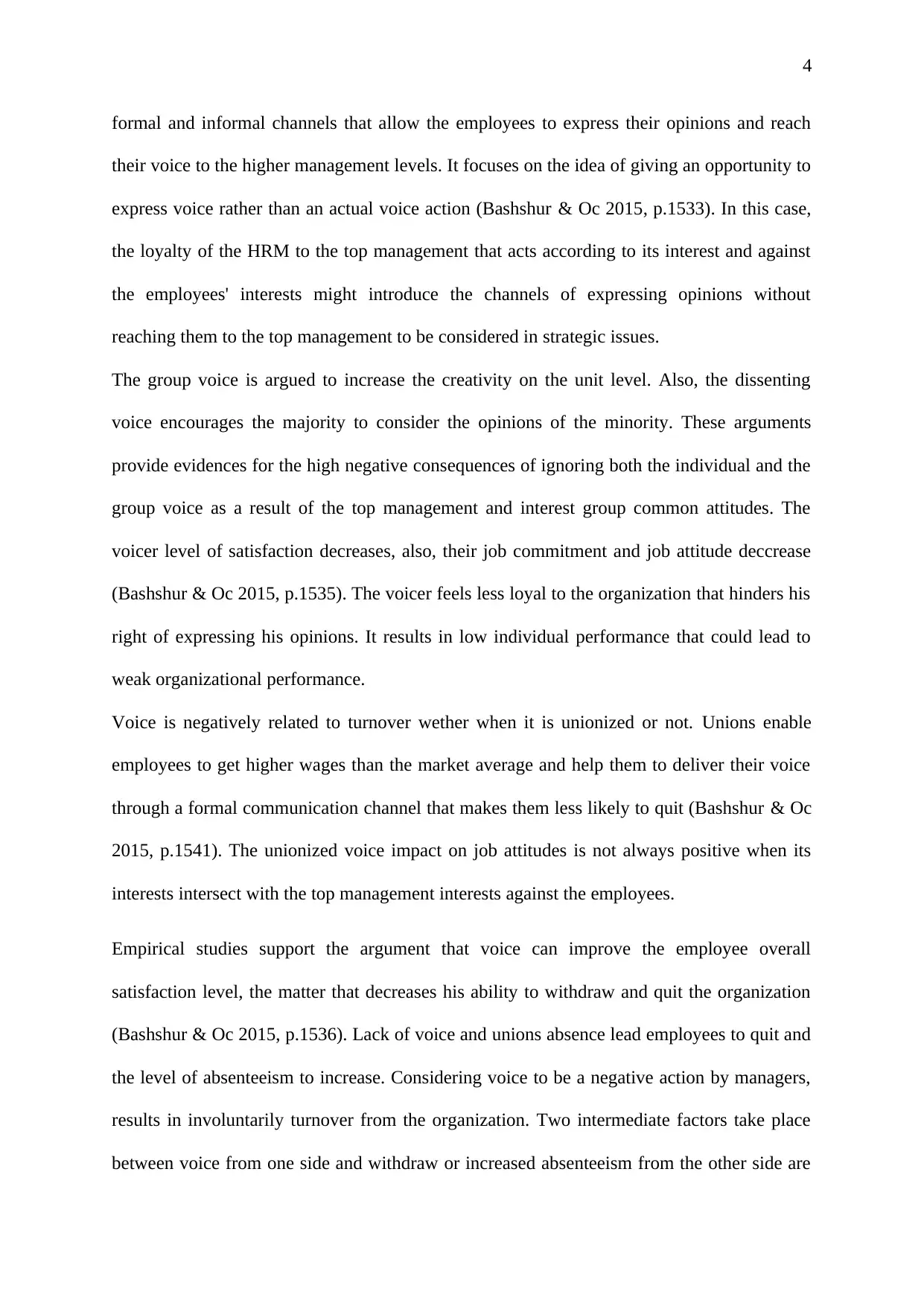
4
formal and informal channels that allow the employees to express their opinions and reach
their voice to the higher management levels. It focuses on the idea of giving an opportunity to
express voice rather than an actual voice action (Bashshur & Oc 2015, p.1533). In this case,
the loyalty of the HRM to the top management that acts according to its interest and against
the employees' interests might introduce the channels of expressing opinions without
reaching them to the top management to be considered in strategic issues.
The group voice is argued to increase the creativity on the unit level. Also, the dissenting
voice encourages the majority to consider the opinions of the minority. These arguments
provide evidences for the high negative consequences of ignoring both the individual and the
group voice as a result of the top management and interest group common attitudes. The
voicer level of satisfaction decreases, also, their job commitment and job attitude deccrease
(Bashshur & Oc 2015, p.1535). The voicer feels less loyal to the organization that hinders his
right of expressing his opinions. It results in low individual performance that could lead to
weak organizational performance.
Voice is negatively related to turnover wether when it is unionized or not. Unions enable
employees to get higher wages than the market average and help them to deliver their voice
through a formal communication channel that makes them less likely to quit (Bashshur & Oc
2015, p.1541). The unionized voice impact on job attitudes is not always positive when its
interests intersect with the top management interests against the employees.
Empirical studies support the argument that voice can improve the employee overall
satisfaction level, the matter that decreases his ability to withdraw and quit the organization
(Bashshur & Oc 2015, p.1536). Lack of voice and unions absence lead employees to quit and
the level of absenteeism to increase. Considering voice to be a negative action by managers,
results in involuntarily turnover from the organization. Two intermediate factors take place
between voice from one side and withdraw or increased absenteeism from the other side are
formal and informal channels that allow the employees to express their opinions and reach
their voice to the higher management levels. It focuses on the idea of giving an opportunity to
express voice rather than an actual voice action (Bashshur & Oc 2015, p.1533). In this case,
the loyalty of the HRM to the top management that acts according to its interest and against
the employees' interests might introduce the channels of expressing opinions without
reaching them to the top management to be considered in strategic issues.
The group voice is argued to increase the creativity on the unit level. Also, the dissenting
voice encourages the majority to consider the opinions of the minority. These arguments
provide evidences for the high negative consequences of ignoring both the individual and the
group voice as a result of the top management and interest group common attitudes. The
voicer level of satisfaction decreases, also, their job commitment and job attitude deccrease
(Bashshur & Oc 2015, p.1535). The voicer feels less loyal to the organization that hinders his
right of expressing his opinions. It results in low individual performance that could lead to
weak organizational performance.
Voice is negatively related to turnover wether when it is unionized or not. Unions enable
employees to get higher wages than the market average and help them to deliver their voice
through a formal communication channel that makes them less likely to quit (Bashshur & Oc
2015, p.1541). The unionized voice impact on job attitudes is not always positive when its
interests intersect with the top management interests against the employees.
Empirical studies support the argument that voice can improve the employee overall
satisfaction level, the matter that decreases his ability to withdraw and quit the organization
(Bashshur & Oc 2015, p.1536). Lack of voice and unions absence lead employees to quit and
the level of absenteeism to increase. Considering voice to be a negative action by managers,
results in involuntarily turnover from the organization. Two intermediate factors take place
between voice from one side and withdraw or increased absenteeism from the other side are

5
'organizational tenure' and 'organizational commitment'. Both of the two factors weaken the
relationship between the employee intention to remain and lack of voice, also, they reduce the
employee intention to stay (Bashshur & Oc 2015, p.1537).
'organizational tenure' and 'organizational commitment'. Both of the two factors weaken the
relationship between the employee intention to remain and lack of voice, also, they reduce the
employee intention to stay (Bashshur & Oc 2015, p.1537).
⊘ This is a preview!⊘
Do you want full access?
Subscribe today to unlock all pages.

Trusted by 1+ million students worldwide
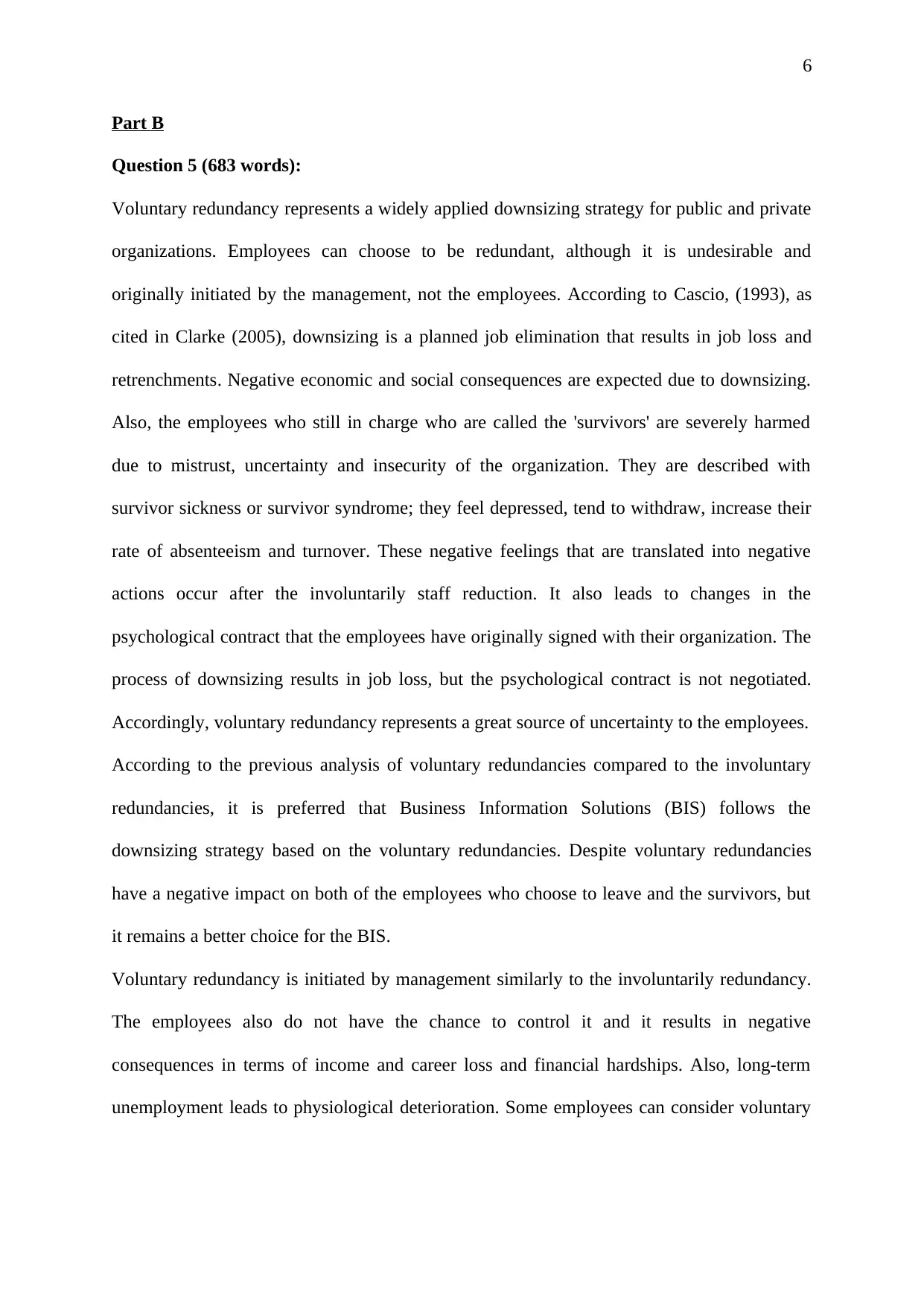
6
Part B
Question 5 (683 words):
Voluntary redundancy represents a widely applied downsizing strategy for public and private
organizations. Employees can choose to be redundant, although it is undesirable and
originally initiated by the management, not the employees. According to Cascio, (1993), as
cited in Clarke (2005), downsizing is a planned job elimination that results in job loss and
retrenchments. Negative economic and social consequences are expected due to downsizing.
Also, the employees who still in charge who are called the 'survivors' are severely harmed
due to mistrust, uncertainty and insecurity of the organization. They are described with
survivor sickness or survivor syndrome; they feel depressed, tend to withdraw, increase their
rate of absenteeism and turnover. These negative feelings that are translated into negative
actions occur after the involuntarily staff reduction. It also leads to changes in the
psychological contract that the employees have originally signed with their organization. The
process of downsizing results in job loss, but the psychological contract is not negotiated.
Accordingly, voluntary redundancy represents a great source of uncertainty to the employees.
According to the previous analysis of voluntary redundancies compared to the involuntary
redundancies, it is preferred that Business Information Solutions (BIS) follows the
downsizing strategy based on the voluntary redundancies. Despite voluntary redundancies
have a negative impact on both of the employees who choose to leave and the survivors, but
it remains a better choice for the BIS.
Voluntary redundancy is initiated by management similarly to the involuntarily redundancy.
The employees also do not have the chance to control it and it results in negative
consequences in terms of income and career loss and financial hardships. Also, long-term
unemployment leads to physiological deterioration. Some employees can consider voluntary
Part B
Question 5 (683 words):
Voluntary redundancy represents a widely applied downsizing strategy for public and private
organizations. Employees can choose to be redundant, although it is undesirable and
originally initiated by the management, not the employees. According to Cascio, (1993), as
cited in Clarke (2005), downsizing is a planned job elimination that results in job loss and
retrenchments. Negative economic and social consequences are expected due to downsizing.
Also, the employees who still in charge who are called the 'survivors' are severely harmed
due to mistrust, uncertainty and insecurity of the organization. They are described with
survivor sickness or survivor syndrome; they feel depressed, tend to withdraw, increase their
rate of absenteeism and turnover. These negative feelings that are translated into negative
actions occur after the involuntarily staff reduction. It also leads to changes in the
psychological contract that the employees have originally signed with their organization. The
process of downsizing results in job loss, but the psychological contract is not negotiated.
Accordingly, voluntary redundancy represents a great source of uncertainty to the employees.
According to the previous analysis of voluntary redundancies compared to the involuntary
redundancies, it is preferred that Business Information Solutions (BIS) follows the
downsizing strategy based on the voluntary redundancies. Despite voluntary redundancies
have a negative impact on both of the employees who choose to leave and the survivors, but
it remains a better choice for the BIS.
Voluntary redundancy is initiated by management similarly to the involuntarily redundancy.
The employees also do not have the chance to control it and it results in negative
consequences in terms of income and career loss and financial hardships. Also, long-term
unemployment leads to physiological deterioration. Some employees can consider voluntary
Paraphrase This Document
Need a fresh take? Get an instant paraphrase of this document with our AI Paraphraser
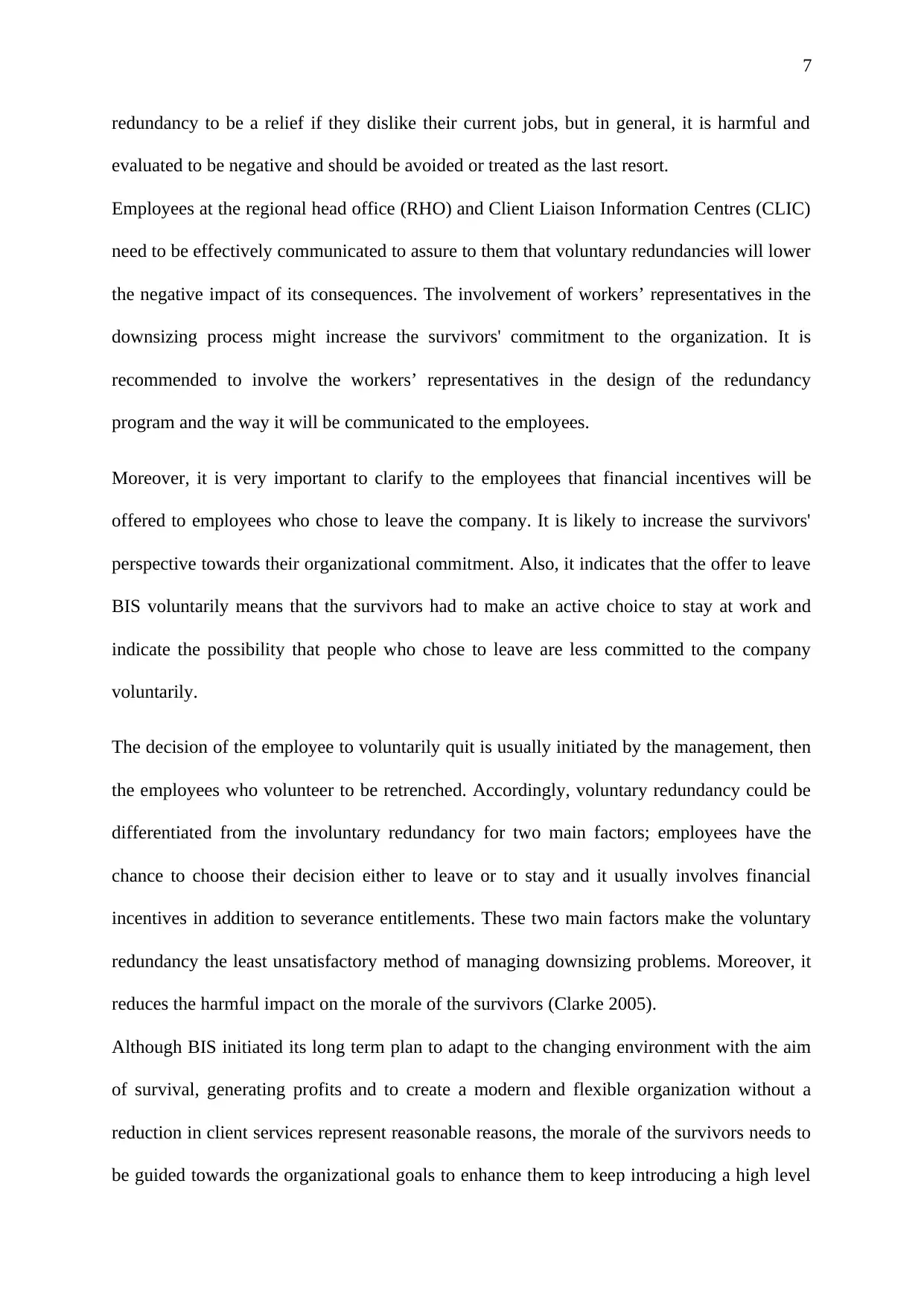
7
redundancy to be a relief if they dislike their current jobs, but in general, it is harmful and
evaluated to be negative and should be avoided or treated as the last resort.
Employees at the regional head office (RHO) and Client Liaison Information Centres (CLIC)
need to be effectively communicated to assure to them that voluntary redundancies will lower
the negative impact of its consequences. The involvement of workers’ representatives in the
downsizing process might increase the survivors' commitment to the organization. It is
recommended to involve the workers’ representatives in the design of the redundancy
program and the way it will be communicated to the employees.
Moreover, it is very important to clarify to the employees that financial incentives will be
offered to employees who chose to leave the company. It is likely to increase the survivors'
perspective towards their organizational commitment. Also, it indicates that the offer to leave
BIS voluntarily means that the survivors had to make an active choice to stay at work and
indicate the possibility that people who chose to leave are less committed to the company
voluntarily.
The decision of the employee to voluntarily quit is usually initiated by the management, then
the employees who volunteer to be retrenched. Accordingly, voluntary redundancy could be
differentiated from the involuntary redundancy for two main factors; employees have the
chance to choose their decision either to leave or to stay and it usually involves financial
incentives in addition to severance entitlements. These two main factors make the voluntary
redundancy the least unsatisfactory method of managing downsizing problems. Moreover, it
reduces the harmful impact on the morale of the survivors (Clarke 2005).
Although BIS initiated its long term plan to adapt to the changing environment with the aim
of survival, generating profits and to create a modern and flexible organization without a
reduction in client services represent reasonable reasons, the morale of the survivors needs to
be guided towards the organizational goals to enhance them to keep introducing a high level
redundancy to be a relief if they dislike their current jobs, but in general, it is harmful and
evaluated to be negative and should be avoided or treated as the last resort.
Employees at the regional head office (RHO) and Client Liaison Information Centres (CLIC)
need to be effectively communicated to assure to them that voluntary redundancies will lower
the negative impact of its consequences. The involvement of workers’ representatives in the
downsizing process might increase the survivors' commitment to the organization. It is
recommended to involve the workers’ representatives in the design of the redundancy
program and the way it will be communicated to the employees.
Moreover, it is very important to clarify to the employees that financial incentives will be
offered to employees who chose to leave the company. It is likely to increase the survivors'
perspective towards their organizational commitment. Also, it indicates that the offer to leave
BIS voluntarily means that the survivors had to make an active choice to stay at work and
indicate the possibility that people who chose to leave are less committed to the company
voluntarily.
The decision of the employee to voluntarily quit is usually initiated by the management, then
the employees who volunteer to be retrenched. Accordingly, voluntary redundancy could be
differentiated from the involuntary redundancy for two main factors; employees have the
chance to choose their decision either to leave or to stay and it usually involves financial
incentives in addition to severance entitlements. These two main factors make the voluntary
redundancy the least unsatisfactory method of managing downsizing problems. Moreover, it
reduces the harmful impact on the morale of the survivors (Clarke 2005).
Although BIS initiated its long term plan to adapt to the changing environment with the aim
of survival, generating profits and to create a modern and flexible organization without a
reduction in client services represent reasonable reasons, the morale of the survivors needs to
be guided towards the organizational goals to enhance them to keep introducing a high level

8
of services to the clients and contribute actively to the high performance of the company as a
whole. Survivors might suffer from the 'survivor guilt' for a long time after the voluntary
redundancies of their peers. The survivors' negative reaction could be considered not only to
be a reaction to the layoff but according to the survivors' perception and evaluation to the
employer, IBS in this case (Bergstrom & Arman 2016).
of services to the clients and contribute actively to the high performance of the company as a
whole. Survivors might suffer from the 'survivor guilt' for a long time after the voluntary
redundancies of their peers. The survivors' negative reaction could be considered not only to
be a reaction to the layoff but according to the survivors' perception and evaluation to the
employer, IBS in this case (Bergstrom & Arman 2016).
⊘ This is a preview!⊘
Do you want full access?
Subscribe today to unlock all pages.

Trusted by 1+ million students worldwide
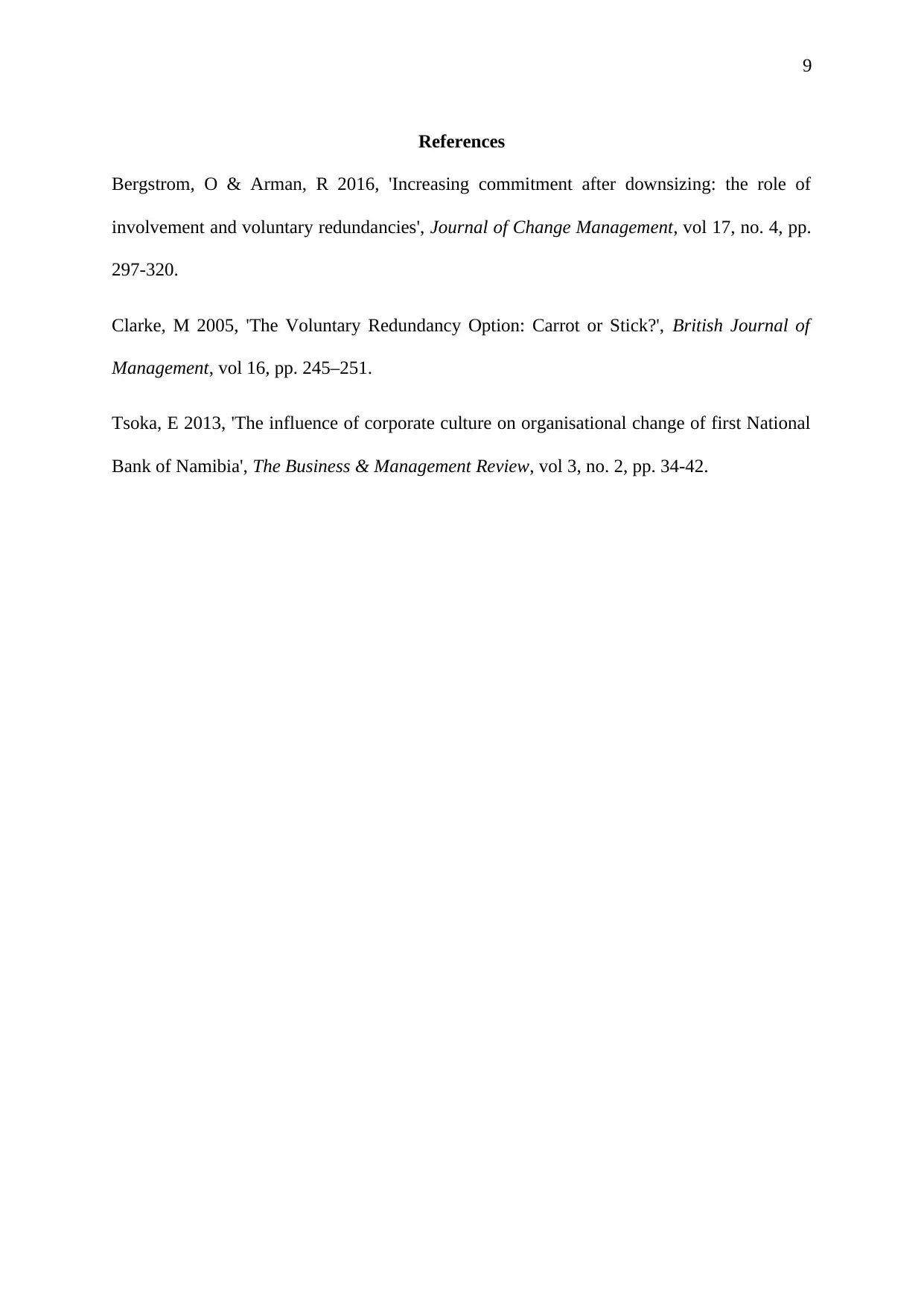
9
References
Bergstrom, O & Arman, R 2016, 'Increasing commitment after downsizing: the role of
involvement and voluntary redundancies', Journal of Change Management, vol 17, no. 4, pp.
297-320.
Clarke, M 2005, 'The Voluntary Redundancy Option: Carrot or Stick?', British Journal of
Management, vol 16, pp. 245–251.
Tsoka, E 2013, 'The influence of corporate culture on organisational change of first National
Bank of Namibia', The Business & Management Review, vol 3, no. 2, pp. 34-42.
References
Bergstrom, O & Arman, R 2016, 'Increasing commitment after downsizing: the role of
involvement and voluntary redundancies', Journal of Change Management, vol 17, no. 4, pp.
297-320.
Clarke, M 2005, 'The Voluntary Redundancy Option: Carrot or Stick?', British Journal of
Management, vol 16, pp. 245–251.
Tsoka, E 2013, 'The influence of corporate culture on organisational change of first National
Bank of Namibia', The Business & Management Review, vol 3, no. 2, pp. 34-42.
1 out of 10
Related Documents
Your All-in-One AI-Powered Toolkit for Academic Success.
+13062052269
info@desklib.com
Available 24*7 on WhatsApp / Email
![[object Object]](/_next/static/media/star-bottom.7253800d.svg)
Unlock your academic potential
Copyright © 2020–2025 A2Z Services. All Rights Reserved. Developed and managed by ZUCOL.





